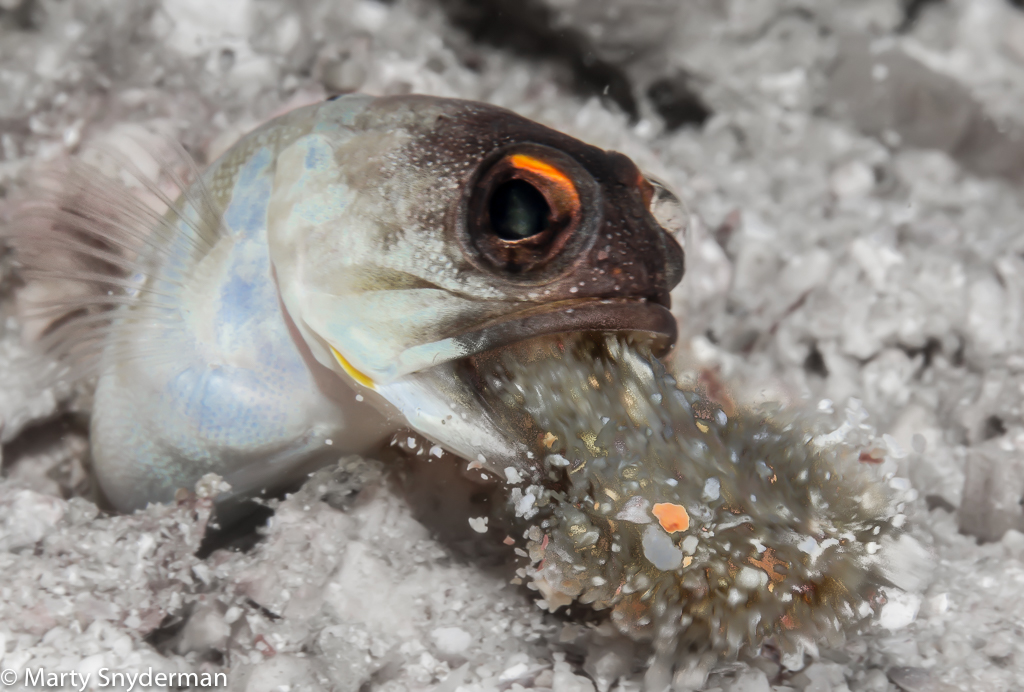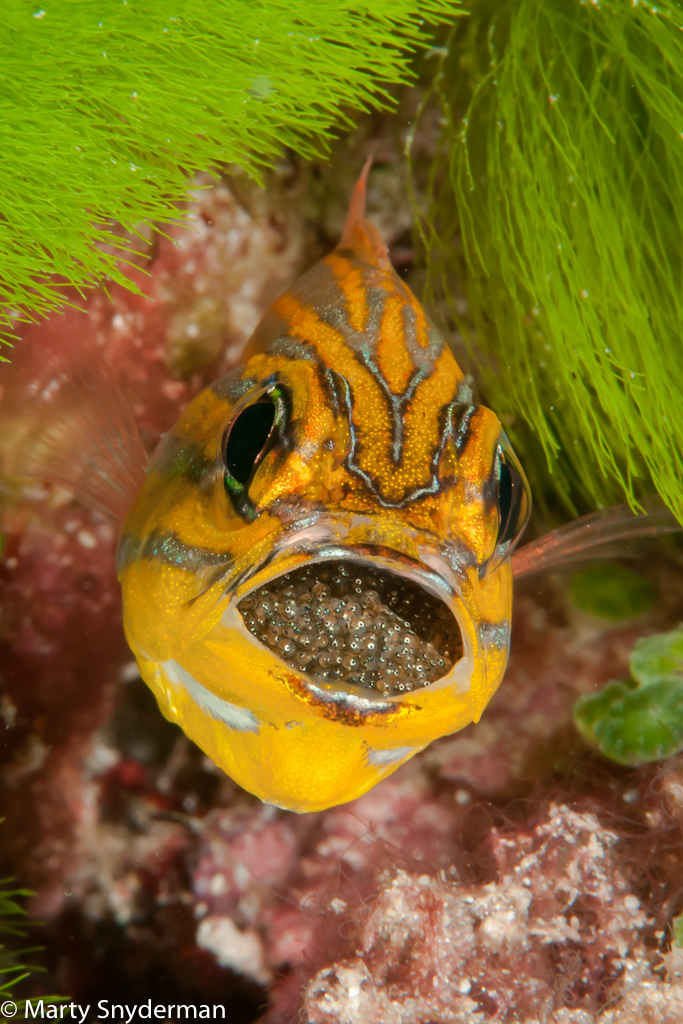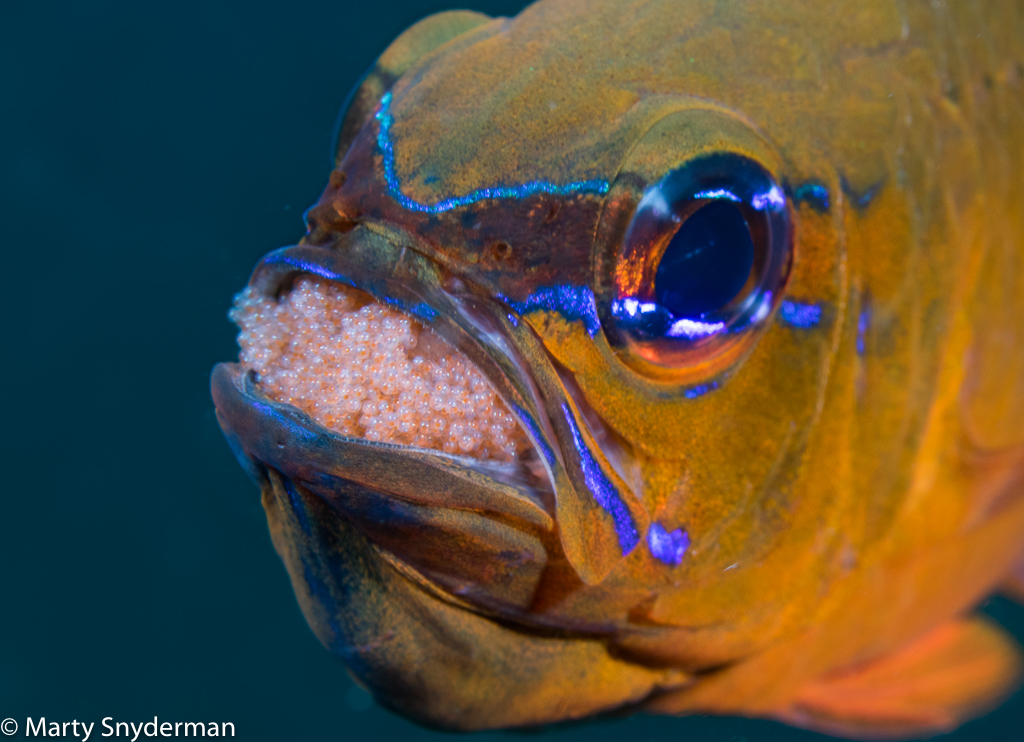Mouthbrooders: Finding the “Mr. Moms” of the Sea
The impressive male fish that carry all the weight in the family

The variety of ways that fish reproduce and bear their young is pretty awe-inspiring. Some species like mandarinfish are broadcast spawners that cast eggs into the water and let the chips fall where they may, with no regard to their young’s survival. Others like sharks give birth to well-developed young that essentially look like miniature, self-sufficient adults at the time they hatch. Species like anemonefish and damselfish lay eggs in nests that are protected until they hatch.
In yet another method of protective reproduction collectively known as mouthbrooding by ichthyologists, the parental male keeps clutches of eggs in its mouth until the young hatch. In this twist of nature seen in the majority of cardinalfish and jawfish, the male broods the eggs in his mouth with little assistance needed from the female, creating an interesting role reversal compared to active females seen in other species.
Affectionately called “Mr. Moms” by many sport divers and hobbyists, these mouth brooders are often seen when scuba diving in Bonaire, Cozumel, Fiji, Honduras, the Philippines, and many other tropical destinations around the globe that are served by Ultimate Dive Travel. As many experienced divers are quick to say, watching one of these Mr. Moms do his thing is sure to make any dive trip a memorable one.
The Species to Look For
While you may never have seen a mouth brooding cardinalfish or jawfish in person, the often overlooked males are easier to find than you’d think. Of the family Apogonidae, the key in cardinalfish is to search for a fish that looks like it has the mumps or a mouth that’s stuffed with too much food. Their swollen cheeks are a dead giveaway. As long as you’re not too aggressive in your approach, males with eggs in their mouths tend to stay in a relatively small area, making them easy to observe. That said, it can still be quite a challenge to photograph one so that the clutch of eggs is visible and prominent. But if you’re patient, every few minutes you’ll probably be able to see the male open its mouth and rotate the clutch of eggs. For the fish, this is a means of keeping the eggs clean and ensuring access to oxygen-rich water. For photographers and videographers, this is the time to shoot!
The common name jawfish is derived from the large mouths and prominent jaws of the fish described in the family Opistognathidae. True to their name, jawfish use their jaws to perform a variety of functions including incubating eggs and moving large rocks as they maintain their burrows. The burrows are typically found in bottoms that consist of a combination of rubble and coarse sand.
Jawfish are distinguished by their relatively large heads that sit atop long, tapering bodies, and big eyes that rotate in their sockets. For the most part, jawfish are drab in color, though splashes of yellow, green, and iridescent spots provide exceptions. They’re extremely energetic and live in burrows that they constantly excavate and maintain.
Various species of jawfish build their burrows in a manner that’s inherent to their species, with all of their building blocks neatly arranged to give them maximum protection. Jawfish rarely venture far from their burrows and they’re quick to return when frightened. If danger seems imminent, they make a quick tail first retreat into their burrow. Once the sun sets, some species cover the opening to their burrows with a piece of shell or rock. This provides them additional protection from potential predators that emerge at night to feed.

The Full Brooding Process

Like this yellowhead jawfish photographed on a scuba dive in Cozumel, most jawfish are mouth brooders with the male incubating fertilized eggs in his mouth until they hatch. A male jawfish attracts females to his burrow to lay her eggs so that he can brood them. Males attract females in a “dance” that includes the spreading of his pectoral fins and arching of his long back. If successfully wooed, she’ll lay her eggs deep within his burrow. The male will then quickly fertilize the eggs, which he then scoops up and holds in his mouth. But every guy deserves a break to eat! When they do, they “spit” the eggs into the burrow, leaving them temporarily unattended.
The incubation period is only five to seven days. Color variations in eggs note changes in the process:
- Light yellow – Eggs are first deposited
- Silver – Days of incubation after deposit
- Gray – Yolks are absorbed by the embryonic
- After gray, eggs hatch a day or so later
Pretty interesting stuff, huh? We hope this information helps you catch sight of this unique species during your next scuba diving adventure. If you’d like to plan your next scuba diving trip, please contact the dive travel experts at Ultimate Dive Travel who are more than happy to help.
